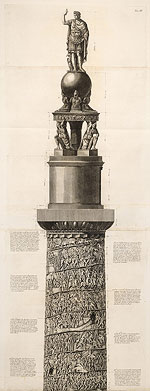 |

 |
 |
View of the Principal Prospect of the Column of Trajan (detail), 1774
|
 |
 |
|
 |
|
 |
|
Architect, archaeologist, polemicist, and printmaker Giovanni Battista Piranesi (Italian, 1720–1778) was a lifelong champion of Rome. He published more than a thousand etchings depicting the 18th-century city and ancient Roman monuments. Piranesi's images were often so magnificent that tourists who had seen them before they visited Rome were sometimes left disappointed by the actual city.
Featuring examples of Piranesi's books and prints in the special collections of the Research Library at the Getty Research Institute, this exhibition presents an overview of his extraordinary range of activities: from penning polemics and recording archaeological data to sketching dramatic views, imagining prisons, and creating stylish advertisements for his wares. Piranesi used six copper plates to produce a spectacular, nearly nine-foot-high etching of the Column of Trajan, one of Rome's most recognizable monuments. The print shows the shaft's spiral narrative frieze, which depicts Roman emperor Trajan's battles against the Dacians of southeastern Europe. Piranesi's magnificent vision of the monument includes the original bronze statue of Trajan, which had been replaced with a figure of Saint Peter in 1587.
|
 |

 |
 |
Title Page for a Catalogue of Antiquities, 1778
|
 |
 |
|
|
 |
|
|
 |
Piranesi's aesthetic of monumentality is evident in his grand views of Rome and in his fantastic compositions of ancient artifacts.
Presenting a decorative assemblage of Roman objects, the title page shown here introduces Piranesi's lavishly illustrated two-volume catalog of antiquities, some of which were sold in his studio.
|
 |
|
With his suite of etchings depicting imaginary prisons, the Carceri (Prisons), Piranesi fashioned a world of pillars and arches that twist and turn with muscular energy.
In this etching, a massive pillar seems to pulse with the energy of the arches that spring to an unknown destination. The image's visual drama is heightened by a frenetic network of sketchy, interweaving lines.
|
 |

 |
 |
Latin and Italian Title Pages, 1761
|
 |
 |
|
|
 |
|
|
 |
The Latin and Italian pages shown here introduce Piranesi's greatest polemical publication on ancient Rome, On the Magnificence and Architecture of Rome. He copied the winged figure of Nike, goddess of victory, from the Column of Trajan and depicted her inscribing the coat of arms of his patron, Pope Clement XIV.
An aggressive display, these pages are packed with symbols of military triumph. Piranesi not only flatters Clement but also declares victory over the French and English antiquarians who claimed that Roman culture was merely derivative of Greek achievements.
|
 |
 |

 |
 |
Ancient Architectural Fragments, 1761
|
 |
 |
|
Publications such as Piranesi's On the Magnificence and Architecture of Rome were designed to be acquired as fine works of art and also to provide surrogate images of antiquities for collectors' libraries and print cabinets.
This print of architectural details from the book makes a visual argument for the superiority of Roman style through dramatic effects of shadow and perspective that give monumental weight to the ancient fragments.
|
 |

 |
 |
View of the Pantheon, 1761
|
 |
 |
For cultural tourists and armchair travelers, Piranesi's Vedute di Roma (Views of Rome) presented an experience of the city that was both documentary and visionary. Between 1746 and 1778, the year of his death, Piranesi produced an incredible 135 large-format prints to promote his conception of Rome.
As Piranesi's style and ideas evolved in the 1750s, his concern for monumentality and unobstructed vistas took precedence over topographical accuracy. In this 1761 print of the Pantheon, the ancient temple's textures and details are rendered with painstaking precision. But the structure is shown from three different angles, providing an impossible simultaneous perspective of the portico, the right side of the main cylinder, and the dome itself.
|
 |
 |

 |
 |
View of an Ancient Shrine, 1762
|
 |
Produced around the same time as the view of the Pantheon was this illustration from Piranesi's archaeological study on two caves near Rome. According to him, the ancient Romans converted the cave in this print into a shrine that hosted orgies.
Here Piranesi presents archaeology as both documentation and an awe-inspiring view of decayed grandeur.
|
 |